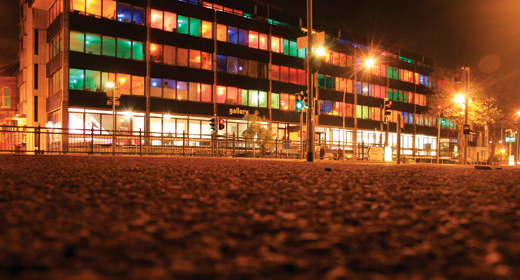Following last year’s inaugural event and rounding off the cultural festival season for the year, comes a second outing for White Night on Saturday 24th. We spoke to Festival Director Donna Close about this unique cultural night on the town, bidding official farewell to British Summertime with a Fortune and Chance-themed arts immersion.
Nick Coquet: It must be difficult maintaining a balance between high art and accessibility for the visitors.
Donna Close: I think Brighton does high art really well and creates some really interesting stuff, but there’s a humour about it or some level of innovation that naturally encourages easy access to it. It’s not an either/or thing like a lot of arts festivals, where it feels like the directors are trying to prove some artistic point. When we started White Night it was about Brighton artists at play – look at what’s out there and go and do something different. I think there’s a kind of pier mentality about it, people are just naturally attracted to the different elements of the programme because of the way they’ve been put together – they inspire a natural curiosity.
NC: The participation element of it all keeps it from being a solely passive experience.
DC: Absolutely, everyone wants to get involved, everyone’s an artist. We have more volunteers than anyone else in the UK and that shows people want to be part of it, they don’t just want to sit back with a beer. Whether that’s taking part in a trail or something like the life drawing at the Komedia – people are going to want to get involved with that. There’s a perception that Brightonians are too cool for school, but that’s just not the case – there’s a performance artist at the Ocean Rooms, she’s learned pole dancing and she’s worked out a theory about movement and colour being associated. So she’s got a routine where she dances in a white outfit and the colours are shone on her.
NC: The festival seems quite a bit bigger than last year.
DC: We had twelve venues last year, this year we’ve got nineteen and about ten outdoor activities. We actually added a new one today, Hollingbury Fort, which is all about shamanic consciousness and traditional Sussex rituals.
NC: So White Night is turning into a permanent fixture on the arts calendar now.
DC: Well, it’s the second year and we’ve got funding for the next two years. A lot of it’s free so we’re not so reliant on ticket sales or anything. It’s really just about trying something a bit different; trying different things in different venues you might not ordinarily visit, persuading people to give them a chance. Having it free makes that a lot easier. We’ve got thousands of students coming into the city and it’s a good showcase for the venues as well as an introduction to the arts for them.
NC: You’ve teamed up with some of the city’s other festivals as well.
DC: Yes, those collaborations are another important part of it. We’ve got Brighton Live doing the city soundtrack trail, and a gig in the Prescription Gallery and also the piano trail, we’ve got CineCity doing the movies in the swimming pool and also the Brighton Photo Biennial. That one’s a good example of what we’re doing actually – they’re usually very high art and we’re getting them to do something that’s a bit funny and tongue-in-cheek. They’re working with the knitting circle, celebrating the fact that postmen work all through the night with a huge tea cosy on a postbox…
NC: The theming of the festival seems to bring everyone together.
DC: It’s just about throwing the theme out there as an idea, and people have so much fun with it. It seems to focus people’s minds and they come back with these amazing, creative ideas that just draw people in. There’s such a diverse mix of participants and they all have a different take on the theme to take inspiration from, it’s brilliant.

